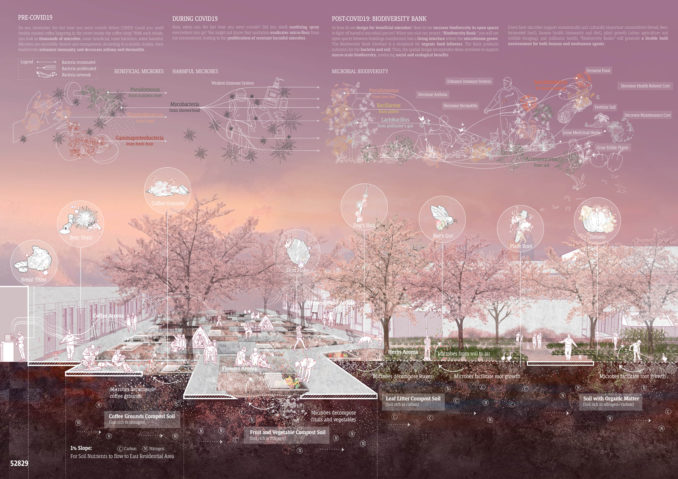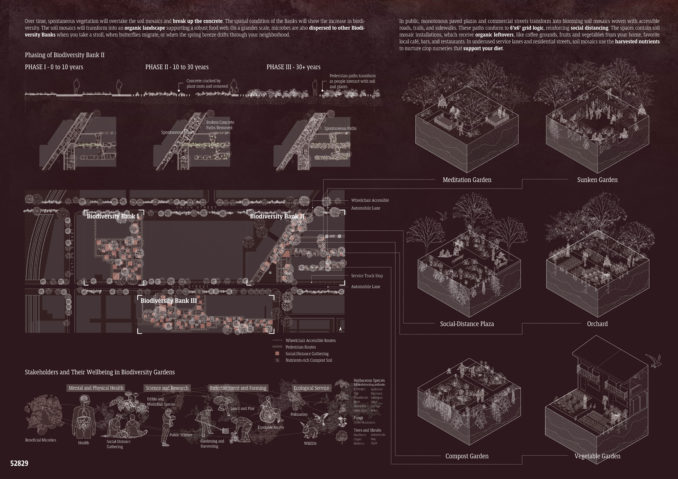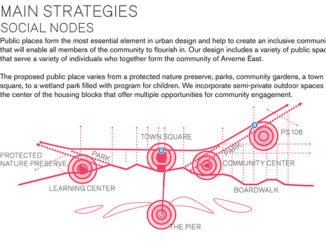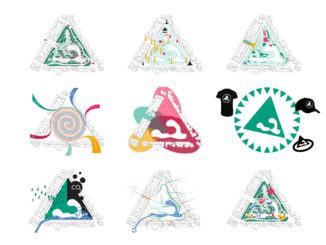Winner of the Reimagining the Spaces in Between Student Ideas Competition

Do you remember the last time you went outside before COVID? Could you smell freshly roasted coffee lingering in the street beside the coffee shop? With each inhale, you took in thousands of microbes, some beneficial, some harmless, some harmful. Some microbes hitch-hiked on skin-flakes, while others floated, airborne in soil particles. Microbes are incredibly diverse and omnipresent. According to scientific studies, their biodiversity enhances immunity and decreases asthma and dermatitis, which is especially crucial for children with developing immune systems.
Now, when was the last time you went outside? Did you smell sanitizing spray everywhere you went? You might not know that sanitation eradicates micro-flora from our environment, leading to the proliferation of resistant harmful microbes.
So how do we design for beneficial microbes? How do we increase biodiversity in open spaces to fight off harmful microbial species?
When you visit our project, “Biodiversity Bank,” you will see open spaces between buildings transformed into a living interface where the microbiome grows. Have you noticed that during COVID, organic disposables have become more abundant, now that your home and kitchen are the center of your life? The Biodiversity Bank interface is a receptacle for organic food leftovers. The Bank produces nutrients for the bacteria and soil. Then, the spatial design incorporates these nutrients to support macro-scale biodiversity, producing social and ecological benefits.

The design concept has two components: 1. Spatially, a system of Biodiversity Banks in the form of soil mosaics. 2. Stakeholder-wise, the transformation of the home and homeowners, as the home becomes a source of micro-biodiversity and scientific discovery, and the homeowners become contributors to scientific knowledge and pollinators of biodiversity.
What does this mean for your neighborhood? In public, monotonous paved plazas and commercial streets transform into blooming soil mosaics woven with accessible roads, trails, and sidewalks. These paths conform to 6’x6’ grid logic, reinforcing social distancing. The spaces contain soil mosaic installations, which receive organic leftovers, like coffee grounds, fruits and vegetables from your home, favorite local café, bars, and restaurants. These soil mosaics serve as soil and micro-biodiversity harvesting facilities. In underused service lanes and residential streets, soil mosaics use the harvested nutrients to nurture crop nurseries that support your diet. As residents and local businesses deposit food leftovers in the biodiversity bank, the bank’s microbial community intermingles. On a grander scale, microbes are also dispersed to other Biodiversity Banks when you take a stroll, when butterflies migrate, or when the spring breeze drifts through your neighborhood.
Over time, spontaneous vegetation will overtake the soil mosaics and break up the concrete. The spatial condition of the Banks will show the increase in biodiversity. The soil mosaics will transform into an organic landscape supporting a robust food web. Given how microbes support economically and culturally important commodities (bread, beer, fermented food), human health (immunity and diet), plant growth (urban agriculture and wildlife foraging), and pollinator health, “Biodiversity Banks” will generate a livable built environment for both human and nonhuman agents.
Students: Joanne (Zhenheng) Li, Tian Wei Li
School: Graduate School of Design, Harvard University
Image and Text Credits: Joanne (Zhenheng) Li, Tian Wei Li



